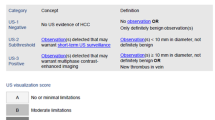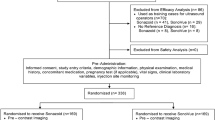Abstract
Ultrasonography (US) is the most commonly used liver imaging modality worldwide. Unfortunately, it has limited sensitivity in the detection of small tumor nodules. Moreover, US findings are often nonspecific, as appearances of benign and malignant liver lesions overlap. The introduction of microbubble contrast agents and the development of contrast-specific techniques have opened new prospects in liver US. The advent of second-generation agents that enable continuous real-time contrast-enhanced imaging has been instrumental in improving the acceptance and reproducibility of the examination. With the publication of guidelines for the use of contrast agents in liver US by the European Federation of Societies for Ultrasound in Medicine and Biology (EFSUMB), contrast-enhanced US has entered clinical practice. The guidelines define the indications and recommendations for the use of contrast agents in focal liver lesion detection, characterization, and posttreatment follow-up. Recently, the clinical value of contrast US as a reliable alternative to CT or MR imaging in characterizing hepatocellular carcinoma in cirrhosis has been endorsed by the practice guideline document issued by the American Association for the Study of Liver Diseases and the 2005 Monothematic Conference on Hepatocellular Carcinoma of the European Association for the Study of the Liver. In this article, the current role of contrast US in the diagnostic management of focal liver lesions is discussed with regard to the following clinical scenarios: (1) characterization of incidental findings; (2) diagnosis of hepatocellular carcinoma in patients with cirrhosis; and (3) identification of hepatic metastases in oncology patients; (4) guidance and monitoring of tumor ablation procedures.
Similar content being viewed by others
References
Llovet JM, Burroughs A, Bruix J (2003) Hepatocellular carcinoma. Lancet 362:1907–1917
Lencioni R, Cioni D, Bartolozzi C (2002) Tissue harmonic and contrast-specific imaging: back to gray scale in ultrasound. Eur Radiol 12:151–165
Lencioni R, Cioni D, Crocetti L et al (2002) Ultrasound imaging of focal liver lesions with a second-generation contrast agent. Acad Radiol 9[Suppl 2]:S371–S374
Albrecht T, Blomley M, Bolondi L et al; EFSUMB Study Group (2004) Guidelines for the use of contrast agents in ultrasound. January 2004. Ultraschall Med 25:249–256
Lencioni R, Cioni D, Crocetti L et al (2004) Magnetic resonance imaging of liver tumors. J Hepatol 40:162–171
Wen YL, Kudo M, Zheng RQ et al (2004) Characterization of hepatic tumors: value of contrast-enhanced coded phase-inversion harmonic angio. AJR Am J Roentgenol 182:1019–1026
Quaia E, Calliada F, Bertolotto M et al (2004) Characterization of focal liver lesions with contrast-specific US modes and a sulfur hexafluoride-filled microbubble contrast agent: diagnostic performance and confidence. Radiology 232:420–430
Kim MJ, Lim HK, Kim SH et al (2004) Evaluation of hepatic focal nodular hyperplasia with contrast-enhanced gray scale harmonic sonography: initial experience. J Ultrasound Med 23:297–305
Bruix J, Sherman M, Llovet JM et al; EASL Panel of Experts on HCC (2001) Clinical management of hepatocellular carcinoma. Conclusions of the Barcelona-2000 EASL conference. European Association for the Study of the Liver. J Hepatol 35:421–430
Lencioni R, Cioni D, Della Pina C et al (2005) Imaging diagnosis. Semin Liver Dis 25:162–170
Nicolau C, Catala V, Vilana R et al (2004) Evaluation of hepatocellular carcinoma using SonoVue, a second generation ultrasound contrast agent: correlation with cellular differentiation. Eur Radiol 14:1092–1099
Gaiani S, Celli N, Piscaglia F et al (2004) Usefulness of contrastenhanced perfusional sonography in the assessment of hepatocellular carcinoma hypervascular at spiral computed tomography. J Hepatol 41:421–426
Oldenburg A, Hohmann J, Foert E et al (2005) Detection of hepatic metastases with low MI real time contrast enhanced sonography and SonoVue. Ultraschall Med 26:277–284
Lencioni R, Crocetti L, Cioni D et al (2004) Percutaneous radiofrequency ablation of hepatic colorectal metastases. Technique, indications, results, and new promises. Invest Radiol 39:689–697
Lencioni R, Cioni D, Crocetti L et al (2005) Early-stage hepatocellular carcinoma in patients with cirrhosis: long-term results of percutaneous image-guided radiofrequency ablation. Radiology 234:961–967
Solbiati L, Ierace T, Tonolini M, Cova L (2004) Guidance and monitoring of radiofrequency liver tumor ablation with contrast-enhanced ultrasound. Eur J Radiol 51[Suppl]:S19–23
Author information
Authors and Affiliations
Corresponding author
Rights and permissions
About this article
Cite this article
Lencioni, R., Della Pina, C., Crocetti, L. et al. Clinical management of focal liver lesions: the key role of real-time contrast-enhanced US. Eur Radiol Suppl 17 (Suppl 6), 73–79 (2007). https://doi.org/10.1007/s10406-007-0231-8
Published:
Issue Date:
DOI: https://doi.org/10.1007/s10406-007-0231-8




